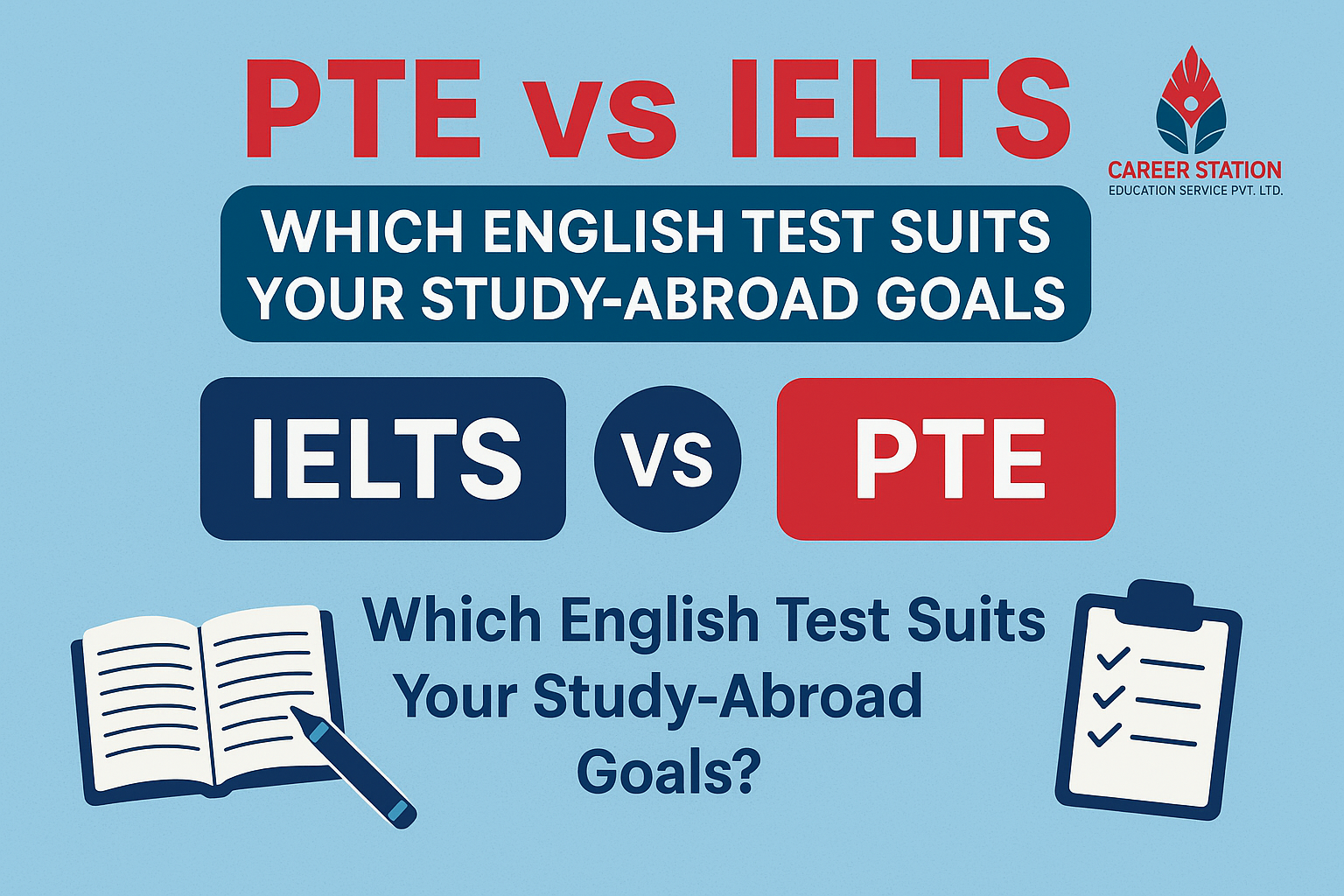
Studying abroad is a dream for many students in Nepal, offering opportunities for world-class education, global exposure, and career advancement. But before securing admission to your dream university, one crucial requirement stands in your way: proving your English language proficiency.
Two
of the most widely accepted tests are the IELTS (International English
Language Testing System) and the PTE (Pearson Test of English). Both
assess your ability to communicate in English across listening, reading,
writing, and speaking. However, they differ in format, scoring, acceptance, and
suitability depending on your goals.
If
you’re struggling with the question, “PTE vs IELTS which one should I choose
for studying abroad?”, this detailed guide will help you decide.
What is IELTS?
Launched
in 1989, IELTS is one of the oldest and most trusted English proficiency
tests worldwide. It is jointly managed by the British Council, IDP: IELTS
Australia, and Cambridge English.
It
is available in two types:
- IELTS Academic – For students applying to universities abroad.
- IELTS General Training – For immigration, work, or training programs.
IELTS Test Format
1.
Listening – 30 minutes with four sections (conversations, lectures,
discussions).
2.
Reading – 60 minutes with academic or general passages.
3.
Writing – 60 minutes (two tasks: essay + report/letter).
4.
Speaking – 11–14 minutes face-to-face interview with an examiner.
IELTS can be taken as paper-based or computer-delivered, depending on availability and student preference.
What is PTE?
The
Pearson Test of English (PTE Academic) is a newer, fully computer-based
English proficiency test developed by Pearson PLC. It has gained popularity for
its speed, convenience, and AI-driven scoring system.
It
is widely accepted in countries like Australia, New Zealand, Canada, the UK,
the USA, and Europe.
PTE Test Format
1.
Speaking &
Writing – 54–67 minutes (includes essay
writing and oral fluency tasks).
2.
Reading – 29–30 minutes (fill in the blanks, multiple choice,
reorder paragraphs).
3.
Listening – 30–43 minutes (summarize spoken text, highlight correct
summary, multiple-choice).
The entire test is conducted on a computer with a headset and microphone, making it suitable for tech-savvy students.
Detailed Comparison: PTE vs IELTS
Category | IELTS | PTE |
Test Type | Paper-based & Computer-based | Fully computer-based |
Scoring System | Band score (0–9) | Score scale (10–90) |
Speaking Test | Face-to-face interview | Recorded on computer |
Result Time | 5–7 days (computer-based may be faster) | 24–48 hours |
Test Duration | 2 hours 45 minutes | 2 hours 15 minutes |
Global Acceptance | 11,000+ institutions worldwide | Accepted in 3,000+ universities, growing rapidly |
Fairness of Scoring | Examiner-based, human influence possible | AI-driven, minimal human bias |
Test Availability | Widely available in Nepal | Limited centers in Nepal but expanding |
Cost in Nepal (approx.) | NPR 27,100 – 28,000 | NPR 25,000 – 27,000 |
Pros and Cons of IELTS
Advantages of IELTS
- Widely accepted by almost every university worldwide
- Option to choose between paper based and computer based tests
- Familiar exam structure for
many students.
- Recognized for immigration
purposes in the UK, Canada, and Australia.
Disadvantages
of IELTS
- Results take longer compared to
PTE.
- Human bias possible in speaking
and writing sections.
- Some students feel nervous
during face-to-face speaking tests.
Pros and Cons of PTE
Advantages
of PTE
- Fully computer-based and
AI-scored (unbiased evaluation).
- Results delivered in 1–2 days,
ideal for urgent applications.
- Shorter test duration compared
to IELTS.
- Easy to book test dates with
flexible schedules.
Disadvantages
of PTE
- Limited availability of test
centers in Nepal.
- Some universities (especially
in the UK and USA) still prefer IELTS over PTE.
- Requires strong typing skills
and comfort with computer-based tasks.
Which Test Should You Choose?
Choose IELTS if:
- You want maximum global
acceptance (especially in the UK and USA).
- You feel more confident with paper-based
tests.
- You prefer speaking
face-to-face with a human examiner.
- You are applying for immigration
to Canada or the UK, where IELTS is highly preferred.
Choose PTE if:
- You want fast results
(within 48 hours).
- You are confident in your computer
skills and typing speed.
- You prefer an AI-based,
unbiased evaluation.
- You are applying for studies in
Australia, New Zealand, or Canada, where PTE is widely accepted.
Expert Tips for Nepali Students
1.
Check your
target country’s visa requirements –
Some countries like Canada and the UK prioritize IELTS.
2.
Review university
policies – While many universities accept
both, a few still prefer IELTS.
3.
Consider your
strengths – If you’re shy in face-to-face
conversations, PTE might feel more comfortable.
4.
Think about
preparation – IELTS coaching classes are more
widely available in Nepal compared to PTE.
5.
Budget and
timeline – If you need results quickly for
an urgent application, PTE is the better option.
Final Thoughts
When
it comes to PTE vs IELTS, there is no universal “better test.” The right
choice depends on your study-abroad destination, personal strengths, and
visa requirements. Both tests open doors to world-class universities, but
the key is choosing the one that aligns with your goals.
At Career Station Nepal, we
specialize in helping students choose the right English proficiency test,
prepare effectively, and secure admissions to their dream universities abroad.
Whether you go with IELTS or PTE, our expert team will guide you at
every step.



